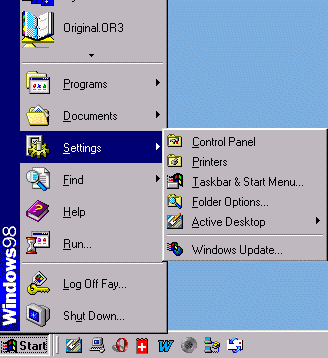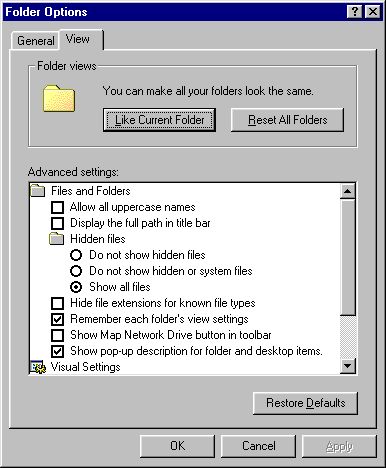File Types
How do I open this file? What IS This File, Anyway?
Don't let Windows hide your files
 It seems to me that Windows has become
increasingly secretive about the workings of computers. One innovation is the hiding of extensions and the complete hiding of certain file types. This, apart from making life much easier for virus writers, sometimes makes it impossible for the user to know which file to click up.
It seems to me that Windows has become
increasingly secretive about the workings of computers. One innovation is the hiding of extensions and the complete hiding of certain file types. This, apart from making life much easier for virus writers, sometimes makes it impossible for the user to know which file to click up.
It's possible for several files within a program to look exactly alike. Some programs, for instance, have a separate ico file. Without the extension, this will look exactly like the exe. You can click on it until the cows come home, but it won't open the program. It may wake up an icon editor, but that's not what you want.
To avoid this, and also to avoid clicking files that shouldn't be there, make sure that extensions are turned on.
Left click on the “Start” button, then slide your cursor up to “Settings”. When the fly-out menu appears, slide across and click on “Control Panel”.

Ignoring all of the pictures, go to the menu bar at the top and click on “View”.
At the very bottom of the View menu, you will see “Folder Options”.
 Click on “Folder Options”. If you see a large, mostly green,picture with a red circle around a folder, click on the View tab at the top.
Click on “Folder Options”. If you see a large, mostly green,picture with a red circle around a folder, click on the View tab at the top.
Now look carefully at the check boxes under “Hidden files”.
Make sure that “Do not show hidden files” is not checked.
Make sure that “Do not show hidden or system files” is not checked.
Make sure that “Show all files,” is checked.
Make sure that “Hide file extensions for known file types” is not checked.
The other settings here are up to you. You can even laughingly check “Remember each folder's view settings,” and sometimes it'll work. (I'd forgotten that annoyance. Since XP it's worked faultlessly.)
If you go “View”, “Folder Options” in an ordinary folder, or if you choose “Folder Options” from the fly-out menu (instead of going through “Settings”) you also have the option of allocating particular programs to open certain file types.
How do I open this file?
People who are new to computers are often perplexed when confronted with a file that won't open with a double click. There are a couple of reasons why this can happen, the first being that some files are not meant to be opened by people.
Every computer program has files that make it “go”; make it open and do whatever it's supposed to do. You don't need to look at these files; only the program itself does. Furthermore, if you were able to open them directly, you might see nothing but gobbledegook.
The second reason might be that you don't have the program to which the file belongs.
Where did you get the file?
Some files are sent to you as attachments to email.
Some are on floppy disks that you either bought or were sent. (well, hardly likely these days—although I still have a drawerful. Most modern computers don't even have a floppy drive.)
Some may be on a CD that you bought or were sent.
Some are downloaded from the internet.
Your computer has a lot of files to make it run. These are called System Files and a beginning user should never try to open, move, copy or delete them without advice from an expert. You will usually get a warning if you try to open system files. Heed it.
Check the file or disk for viruses.
Whether you were given the file by Great Aunt Matilda who is 93 and has devoted her life to good works, or whether you bought a disk or CD from a reputable computer shop makes no difference. Check it.
For a single file, you right-click and find the name of your anti-virus program on the menu, click and wait for the message that the file is clean.
For a floppy disk or CD, put it into the appropriate drive, right click on that drive and choose your anti-virus program on the menu. You might have to wait a few minutes. Just remember that it takes a lot longer to clean a virus from your computer. When the check is finished, you can confidently look at the file.
If it's a single file
For most single files, a double click works. If it doesn't, try dragging the file and dropping it onto the shortcut of a program you think might open it. It's often a good idea to try this with your internet browser.
If that doesn't work, email the person who sent you the file and ask them to which program it belongs.
If you don't have that particular program, and the sender feels the file is important, they might save it in a different format and send that. If it's some rather fancy music or movie file and just for amusement, you can tell the person that you can't view it; end of story. Don't feel obliged to buy or download the latest version of program X just to look at one file.
If it's a lot of files on a disk
First off, look at the disk and any cover it came in. It's very likely that there are instructions, perhaps something like the following.
To run, place in floppy drive and type name e.g. A:\>name of program or even just 'A:/name of program' or 'name of program to run'.
A friend told me that she'd followed these instructions and nothing happened. No, because the instructions forget to say where to do this magical typing. The instructions should read:
First Way
1. Put the disk into the appropriate drive.
2. Open My Computer, put your cursor on the icon representing that drive.
2. Right click and virus check the disk. Remember that this may take a few minutes.
3. Click the Start button at bottom left of your screen.
4. Click Run on the menu that appears.
5. Click Browse.
6. Click your way up to where you can see the disc.
7. Click on the disc.
8. Find a file called name of program.exe or name of program.inf.
9. Double click the file called name of program.exe or name of program.inf. Click OK on the Run box.
Second Way
There's a shorter way of getting the same result, too.
Note: Using Start > Run will only show executable files (of different types) while the following method will show all files. Using Start > Run is probably less confusing if you're unsure.
1. Put the disk into the appropriate drive.
2. Open My Computer, put your cursor on the icon representing that drive.
2. Right click and virus check the disk.
3. Double click the disk. You'll now see several files, or many.
4. Find a file called name of program.exe or name of program.inf.
5. Double click the file called name of program.exe or name of program.inf.
If That Doesn't Work
Occasionally the disk may contain an older program that uses a slightly different way of starting.
If double clicking the exe file results in a brief blink and perhaps an error message, look for a file with the same name—name of program in our example— but an extension of com or bat.
Double clicking either the com or bat file (or running from the start menu as explained above) should make something useful happen.
Zip Files
If the only file you see has the extension zip, the first thing you have to do is unzip it.
With any luck, you already have a program that will do this. (Since Windows XP, there's a built-in unzipping facility. Great!) Before unzipping anything, make a new folder and put the zip file inside it. When the zip program suggests a destination for the unzipped files, browse to that folder.
A zip can contain any number of files and you don't want them scattered over your desktop or interspersed among other files in a directory.
OK, after virus checking, just double click the zip file and follow the instructions in the program that opens.
If nothing happens, or if you get an error message, you need an unzipping program. The best known is WinZip, but WinZip has to be paid for after a trial period.
There are free zip programs available on the Internet. One comes from Vallen Freeware.
If you locate a different free zip program and it asks you to fill in a form before downloading, don't accept; find one that doesn't. Also, remember to run Malwarebytes before and after installing any freeware.
What IS This File, Anyway?
Sometimes, even if you're not going to open it, you'd like to know what a file is, what it does, or to which program it belongs.
This is especially true if you press ctrl+alt+del and see a list that you feel is too long. You can check just what a running program is and what it's for at Answers That Work.
Several sites offer lists of file extensions and tell you with which programs they're associated. One is Stack.com and another is Whatis?com.
Each of these sites opens on a page with alphabet buttons. Click on the first letter of your file or extension and scroll down the page that comes up.
There are others, and if you want to you can Google for them by typing in "file extensions", but my experience is that if a file or extension isn't found on one of these sites you probably won't find it anywhere.
Some files belong to small specialist programs that are used within an organisation and they're just not listed anywhere. Infodisk files, with the extension low, are a case in point.
Questions or comments? I’d love to hear from you. My email address is here.
Return to top
20/8/2002